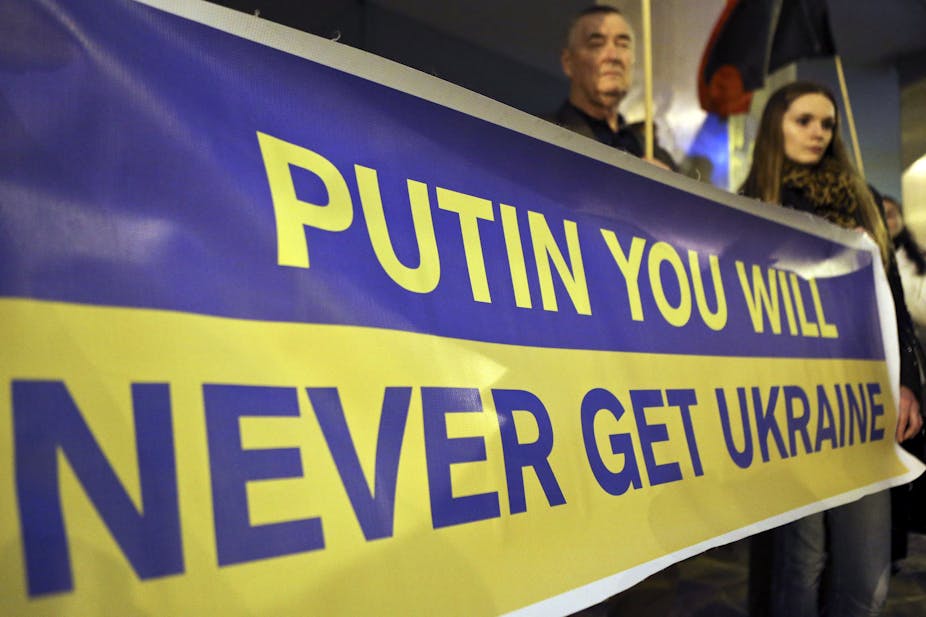On May 26, the day after Ukraine elected Petro Poroshenko its president, a meme surfaced on the Russian Internet (or RuNet, as it’s colloquially known) depicting Ukraine as a chocolate bar. A reference to Poroshenko’s confectionery business, which has earned him the nickname “chocolate king”, it includes Crimea as just one of many pieces to be broken off:
Two months later, @RuNetMemes tweeted an eerie depiction of Vladimir Putin as a land-grabbing ghoul with a claw-like hand stretching upwards toward a representation of the downed Malaysia Airlines flight 17:
As of September 2014, a plethora of sardonic Russian and Ukrainian memes have offered perspectives on the conflict. The Russian-Ukrainian conflict has encouraged the production of internet memes as an outlet for political and social critique, given the memetic emphasis placed on salient peoples and issues related to the conflict.
One of the first memes to emerge was the Yarosh Business Card meme.
Debunked
On April 20, a deadly shootout took place in the eastern Ukrainian city of Sloviansk, killing several people. Ukrainian and Russian accounts of the incident were, as ever, at odds over the question of responsibility: the Russian Foreign Ministry blamed the Ukrainian far-right political party “Right Sector” (Pravy Sektor), led by Dmytro Yarosh.
The Russian Foreign Ministry’s position followed from a story on Russian TV station Life News, which claimed pro-Russian militants had found Yarosh’s business card among detritus left by the alleged attackers.
Kiev rejected the Kremlin’s accusation as ridiculous and absurd – and in retaliation to Russia’s accusation, pro-Ukrainian activists created the @vizitkayarosha (@ВизиткаЯроша) Twitter account and began using it to heap derision on the Russian version of events.
They remixed the business card with innumerable pop culture references: Yoda, Ace Ventura and Agent Mulder of the X-Files, all wielding the Yarosh business card (a Google image search for “Yarosh business card” just begins to show the full range of examples).
The elevation of the Yarosh business card to memetic level is a demonstration of just how ridiculous many Ukrainians regard Russia’s deflection of blame to be. But it also shows how meme culture in Russia and Ukraine is defined by its heavy use of Western (and particularly American) references – and that heavy reliance on Western pop culture, in turn, has its roots in the way political irony was treated in the Soviet era.
In Soviet Russia…
As Anna Sanina has pointed out, during the Stalin years, political irony was a punishable offence. While the severity of the offence may have diminished in later years, with the emergence of carefully constructed anti-Soviet jokes in the 1960s-1980s, the Putin era has seen the return of harsh internal censorship – censorship that takes a dim view indeed of any jibes at Russian leadership.
And yet, memes and visual satire have proliferated throughout the Ukraine conflict. The memes and images circulating via @RuNetMemes and @ВизиткаЯроша and on the internet community known as “Potsreotizm” all exude irony, directly mocking Russian nationalism with a style of humour Sanina calls “blind patriotism reductio ad absurdum”.
Perhaps the best examples are the memes that grew up around the Ukrainian flag.
Colour revolution
To sardonically press the case for another “Colour Revolution”, the blue and yellow colours of the Ukrainian flag have been used to goad and tease Russian authorities as tensions between the two countries have ratched up.
This particular strain of visual protest goes beyond the digital: on August 20, someone hung the flag of Ukraine on one of the “Seven Sister” skyscrapers in Moscow, and painted the derelict Soviet star at its top blue and yellow.
The same was done to one of Moscow’s electricity towers overnight. And digital protesters have picked up the blue and yellow theme to depict Ukraine as heroic underdog (and remixed as a blue and yellow spiderman), to belittle Russia’s authoritarianism, and to mock Putin himself:
The vibrant culture of digital protest that’s grown up around the Ukraine crisis has shown how memes aren’t just for cat pictures: they’re a conduit for meaningful discussion, political subversion, and actual critical debate. They’re also a particularly tempting tool for the dissemination of protest in an environment that harshly polices more overtly serious varieties of dissent.
And in a conflict as confused and murky as this one, the messages they convey are clearer-cut and easier to interpret than any news report or official statement.
Military hostilities may be on hiatus, with a fragile ceasefire in place, but don’t expect the meme machine on either side to stop any time soon.

